Entrepreneurship and Innovation: Roles, Concepts and Significance
VerifiedAdded on 2020/11/12
|10
|2669
|223
Report
AI Summary
This report delves into the concepts of innovation management and entrepreneurship, highlighting their similarities and differences. It explores key motivators behind entrepreneurial activities, providing examples such as passion, money, opportunities, and control. The report then defines gazelles, their characteristics, and their significance to national and regional development, emphasizing their role in job creation and economic growth. Finally, it examines the role of innovation champions within organizations, focusing on their ability to generate opportunities, develop capabilities, and drive innovation. The report concludes by summarizing the importance of continuous innovation for organizational success and the vital role entrepreneurs play in fostering economic growth through innovation and business expansion.
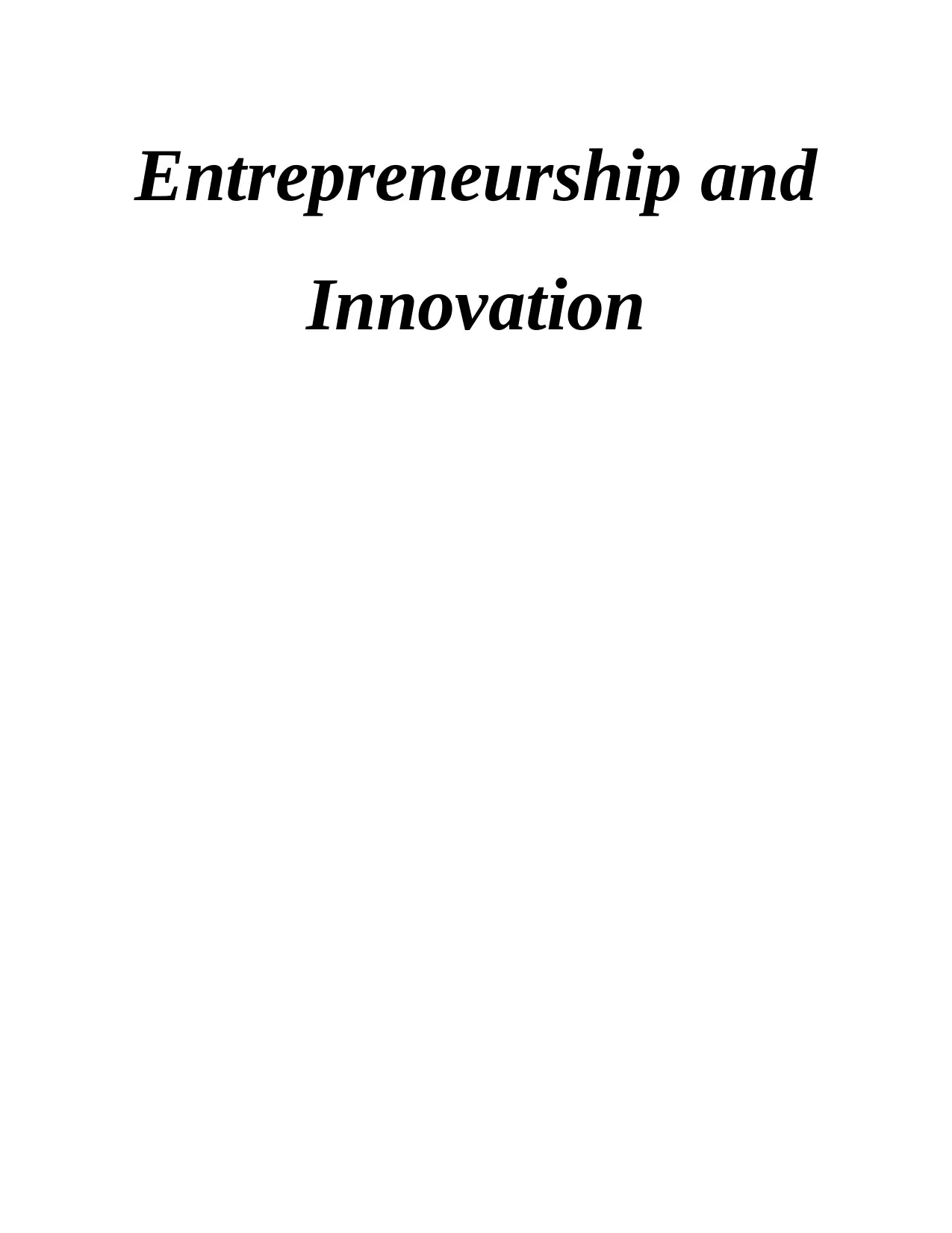
Entrepreneurship and
Innovation
Innovation
Paraphrase This Document
Need a fresh take? Get an instant paraphrase of this document with our AI Paraphraser
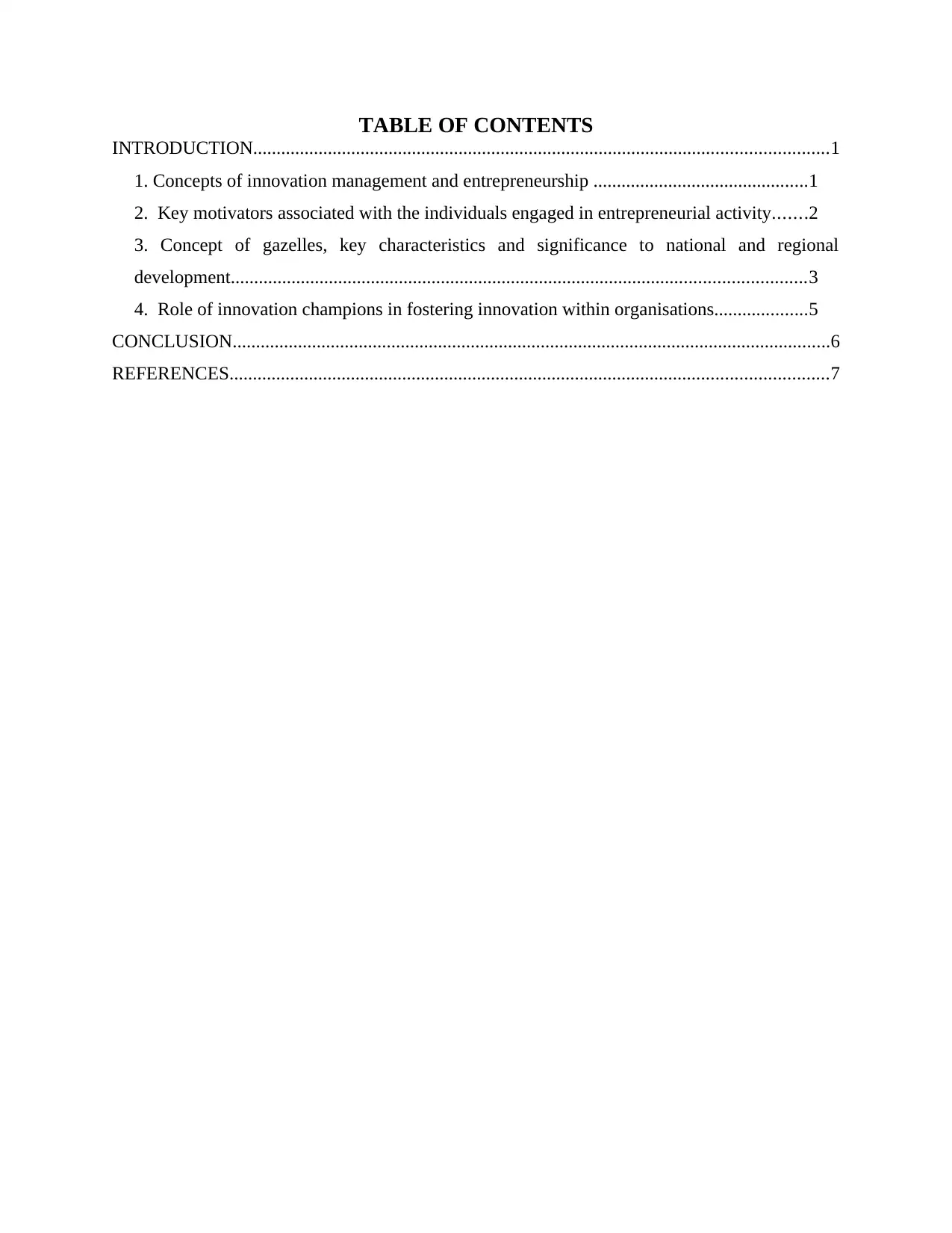
TABLE OF CONTENTS
INTRODUCTION...........................................................................................................................1
1. Concepts of innovation management and entrepreneurship ..............................................1
2. Key motivators associated with the individuals engaged in entrepreneurial activity.......2
3. Concept of gazelles, key characteristics and significance to national and regional
development...........................................................................................................................3
4. Role of innovation champions in fostering innovation within organisations....................5
CONCLUSION................................................................................................................................6
REFERENCES................................................................................................................................7
INTRODUCTION...........................................................................................................................1
1. Concepts of innovation management and entrepreneurship ..............................................1
2. Key motivators associated with the individuals engaged in entrepreneurial activity.......2
3. Concept of gazelles, key characteristics and significance to national and regional
development...........................................................................................................................3
4. Role of innovation champions in fostering innovation within organisations....................5
CONCLUSION................................................................................................................................6
REFERENCES................................................................................................................................7
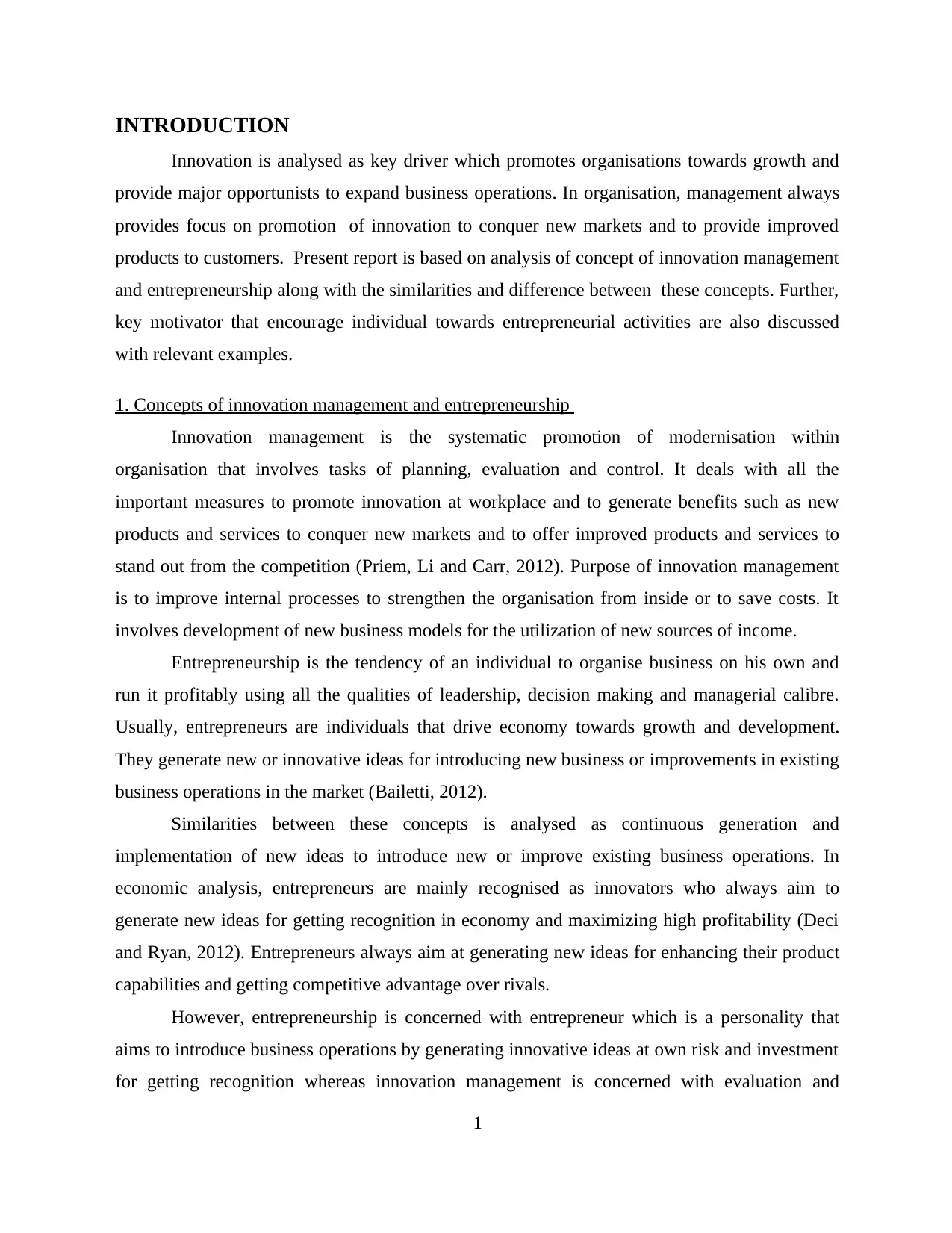
INTRODUCTION
Innovation is analysed as key driver which promotes organisations towards growth and
provide major opportunists to expand business operations. In organisation, management always
provides focus on promotion of innovation to conquer new markets and to provide improved
products to customers. Present report is based on analysis of concept of innovation management
and entrepreneurship along with the similarities and difference between these concepts. Further,
key motivator that encourage individual towards entrepreneurial activities are also discussed
with relevant examples.
1. Concepts of innovation management and entrepreneurship
Innovation management is the systematic promotion of modernisation within
organisation that involves tasks of planning, evaluation and control. It deals with all the
important measures to promote innovation at workplace and to generate benefits such as new
products and services to conquer new markets and to offer improved products and services to
stand out from the competition (Priem, Li and Carr, 2012). Purpose of innovation management
is to improve internal processes to strengthen the organisation from inside or to save costs. It
involves development of new business models for the utilization of new sources of income.
Entrepreneurship is the tendency of an individual to organise business on his own and
run it profitably using all the qualities of leadership, decision making and managerial calibre.
Usually, entrepreneurs are individuals that drive economy towards growth and development.
They generate new or innovative ideas for introducing new business or improvements in existing
business operations in the market (Bailetti, 2012).
Similarities between these concepts is analysed as continuous generation and
implementation of new ideas to introduce new or improve existing business operations. In
economic analysis, entrepreneurs are mainly recognised as innovators who always aim to
generate new ideas for getting recognition in economy and maximizing high profitability (Deci
and Ryan, 2012). Entrepreneurs always aim at generating new ideas for enhancing their product
capabilities and getting competitive advantage over rivals.
However, entrepreneurship is concerned with entrepreneur which is a personality that
aims to introduce business operations by generating innovative ideas at own risk and investment
for getting recognition whereas innovation management is concerned with evaluation and
1
Innovation is analysed as key driver which promotes organisations towards growth and
provide major opportunists to expand business operations. In organisation, management always
provides focus on promotion of innovation to conquer new markets and to provide improved
products to customers. Present report is based on analysis of concept of innovation management
and entrepreneurship along with the similarities and difference between these concepts. Further,
key motivator that encourage individual towards entrepreneurial activities are also discussed
with relevant examples.
1. Concepts of innovation management and entrepreneurship
Innovation management is the systematic promotion of modernisation within
organisation that involves tasks of planning, evaluation and control. It deals with all the
important measures to promote innovation at workplace and to generate benefits such as new
products and services to conquer new markets and to offer improved products and services to
stand out from the competition (Priem, Li and Carr, 2012). Purpose of innovation management
is to improve internal processes to strengthen the organisation from inside or to save costs. It
involves development of new business models for the utilization of new sources of income.
Entrepreneurship is the tendency of an individual to organise business on his own and
run it profitably using all the qualities of leadership, decision making and managerial calibre.
Usually, entrepreneurs are individuals that drive economy towards growth and development.
They generate new or innovative ideas for introducing new business or improvements in existing
business operations in the market (Bailetti, 2012).
Similarities between these concepts is analysed as continuous generation and
implementation of new ideas to introduce new or improve existing business operations. In
economic analysis, entrepreneurs are mainly recognised as innovators who always aim to
generate new ideas for getting recognition in economy and maximizing high profitability (Deci
and Ryan, 2012). Entrepreneurs always aim at generating new ideas for enhancing their product
capabilities and getting competitive advantage over rivals.
However, entrepreneurship is concerned with entrepreneur which is a personality that
aims to introduce business operations by generating innovative ideas at own risk and investment
for getting recognition whereas innovation management is concerned with evaluation and
1
⊘ This is a preview!⊘
Do you want full access?
Subscribe today to unlock all pages.

Trusted by 1+ million students worldwide
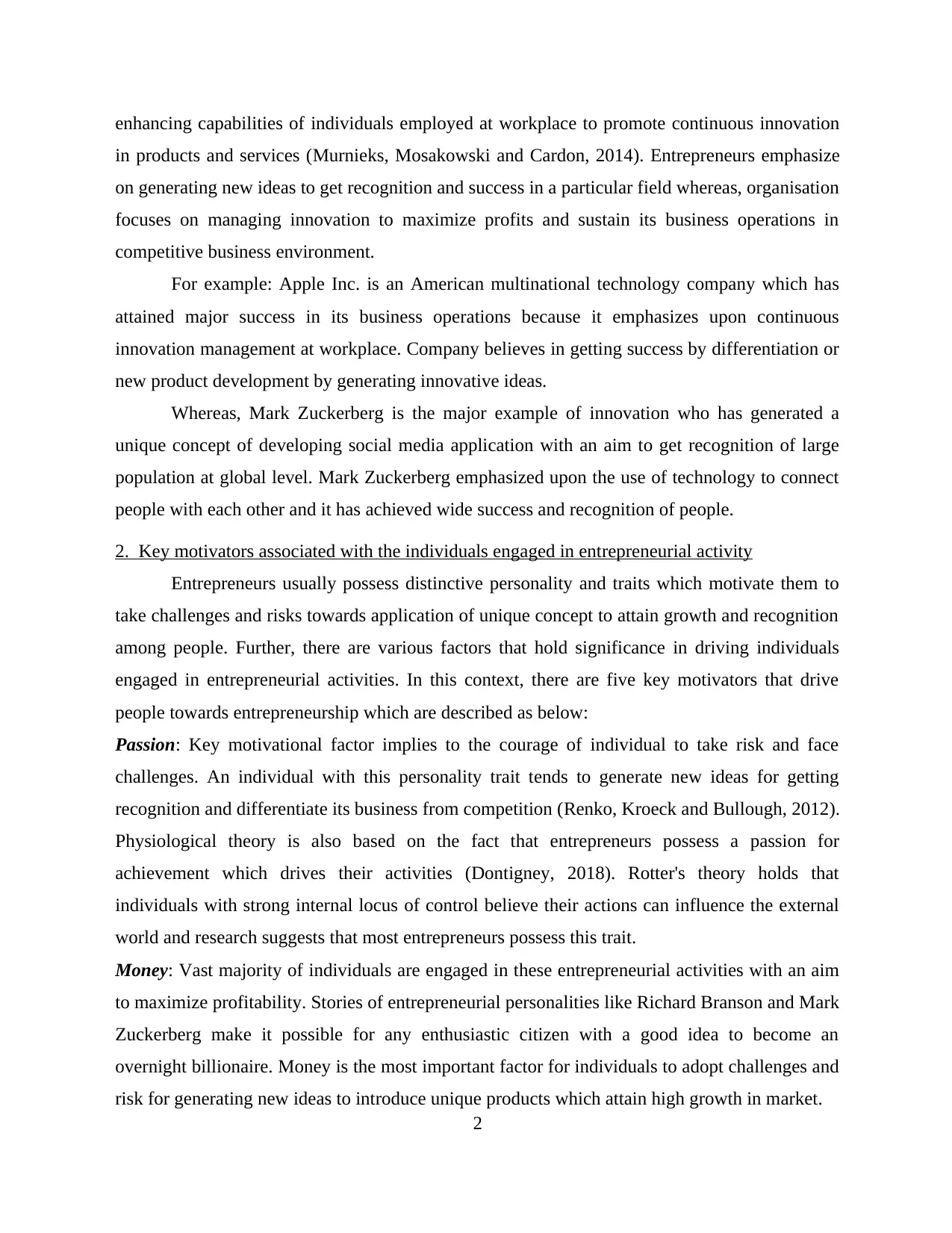
enhancing capabilities of individuals employed at workplace to promote continuous innovation
in products and services (Murnieks, Mosakowski and Cardon, 2014). Entrepreneurs emphasize
on generating new ideas to get recognition and success in a particular field whereas, organisation
focuses on managing innovation to maximize profits and sustain its business operations in
competitive business environment.
For example: Apple Inc. is an American multinational technology company which has
attained major success in its business operations because it emphasizes upon continuous
innovation management at workplace. Company believes in getting success by differentiation or
new product development by generating innovative ideas.
Whereas, Mark Zuckerberg is the major example of innovation who has generated a
unique concept of developing social media application with an aim to get recognition of large
population at global level. Mark Zuckerberg emphasized upon the use of technology to connect
people with each other and it has achieved wide success and recognition of people.
2. Key motivators associated with the individuals engaged in entrepreneurial activity
Entrepreneurs usually possess distinctive personality and traits which motivate them to
take challenges and risks towards application of unique concept to attain growth and recognition
among people. Further, there are various factors that hold significance in driving individuals
engaged in entrepreneurial activities. In this context, there are five key motivators that drive
people towards entrepreneurship which are described as below:
Passion: Key motivational factor implies to the courage of individual to take risk and face
challenges. An individual with this personality trait tends to generate new ideas for getting
recognition and differentiate its business from competition (Renko, Kroeck and Bullough, 2012).
Physiological theory is also based on the fact that entrepreneurs possess a passion for
achievement which drives their activities (Dontigney, 2018). Rotter's theory holds that
individuals with strong internal locus of control believe their actions can influence the external
world and research suggests that most entrepreneurs possess this trait.
Money: Vast majority of individuals are engaged in these entrepreneurial activities with an aim
to maximize profitability. Stories of entrepreneurial personalities like Richard Branson and Mark
Zuckerberg make it possible for any enthusiastic citizen with a good idea to become an
overnight billionaire. Money is the most important factor for individuals to adopt challenges and
risk for generating new ideas to introduce unique products which attain high growth in market.
2
in products and services (Murnieks, Mosakowski and Cardon, 2014). Entrepreneurs emphasize
on generating new ideas to get recognition and success in a particular field whereas, organisation
focuses on managing innovation to maximize profits and sustain its business operations in
competitive business environment.
For example: Apple Inc. is an American multinational technology company which has
attained major success in its business operations because it emphasizes upon continuous
innovation management at workplace. Company believes in getting success by differentiation or
new product development by generating innovative ideas.
Whereas, Mark Zuckerberg is the major example of innovation who has generated a
unique concept of developing social media application with an aim to get recognition of large
population at global level. Mark Zuckerberg emphasized upon the use of technology to connect
people with each other and it has achieved wide success and recognition of people.
2. Key motivators associated with the individuals engaged in entrepreneurial activity
Entrepreneurs usually possess distinctive personality and traits which motivate them to
take challenges and risks towards application of unique concept to attain growth and recognition
among people. Further, there are various factors that hold significance in driving individuals
engaged in entrepreneurial activities. In this context, there are five key motivators that drive
people towards entrepreneurship which are described as below:
Passion: Key motivational factor implies to the courage of individual to take risk and face
challenges. An individual with this personality trait tends to generate new ideas for getting
recognition and differentiate its business from competition (Renko, Kroeck and Bullough, 2012).
Physiological theory is also based on the fact that entrepreneurs possess a passion for
achievement which drives their activities (Dontigney, 2018). Rotter's theory holds that
individuals with strong internal locus of control believe their actions can influence the external
world and research suggests that most entrepreneurs possess this trait.
Money: Vast majority of individuals are engaged in these entrepreneurial activities with an aim
to maximize profitability. Stories of entrepreneurial personalities like Richard Branson and Mark
Zuckerberg make it possible for any enthusiastic citizen with a good idea to become an
overnight billionaire. Money is the most important factor for individuals to adopt challenges and
risk for generating new ideas to introduce unique products which attain high growth in market.
2
Paraphrase This Document
Need a fresh take? Get an instant paraphrase of this document with our AI Paraphraser
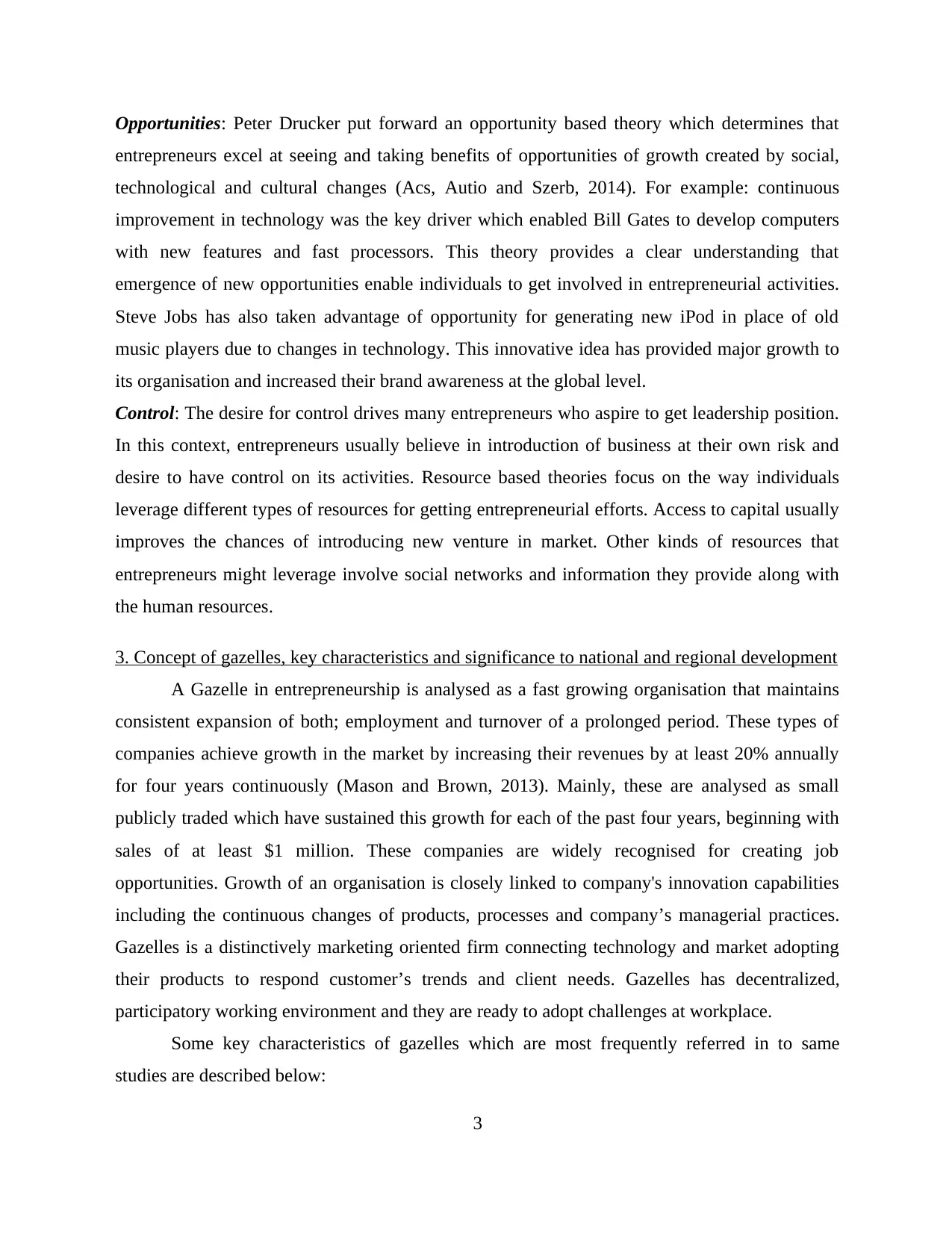
Opportunities: Peter Drucker put forward an opportunity based theory which determines that
entrepreneurs excel at seeing and taking benefits of opportunities of growth created by social,
technological and cultural changes (Acs, Autio and Szerb, 2014). For example: continuous
improvement in technology was the key driver which enabled Bill Gates to develop computers
with new features and fast processors. This theory provides a clear understanding that
emergence of new opportunities enable individuals to get involved in entrepreneurial activities.
Steve Jobs has also taken advantage of opportunity for generating new iPod in place of old
music players due to changes in technology. This innovative idea has provided major growth to
its organisation and increased their brand awareness at the global level.
Control: The desire for control drives many entrepreneurs who aspire to get leadership position.
In this context, entrepreneurs usually believe in introduction of business at their own risk and
desire to have control on its activities. Resource based theories focus on the way individuals
leverage different types of resources for getting entrepreneurial efforts. Access to capital usually
improves the chances of introducing new venture in market. Other kinds of resources that
entrepreneurs might leverage involve social networks and information they provide along with
the human resources.
3. Concept of gazelles, key characteristics and significance to national and regional development
A Gazelle in entrepreneurship is analysed as a fast growing organisation that maintains
consistent expansion of both; employment and turnover of a prolonged period. These types of
companies achieve growth in the market by increasing their revenues by at least 20% annually
for four years continuously (Mason and Brown, 2013). Mainly, these are analysed as small
publicly traded which have sustained this growth for each of the past four years, beginning with
sales of at least $1 million. These companies are widely recognised for creating job
opportunities. Growth of an organisation is closely linked to company's innovation capabilities
including the continuous changes of products, processes and company’s managerial practices.
Gazelles is a distinctively marketing oriented firm connecting technology and market adopting
their products to respond customer’s trends and client needs. Gazelles has decentralized,
participatory working environment and they are ready to adopt challenges at workplace.
Some key characteristics of gazelles which are most frequently referred in to same
studies are described below:
3
entrepreneurs excel at seeing and taking benefits of opportunities of growth created by social,
technological and cultural changes (Acs, Autio and Szerb, 2014). For example: continuous
improvement in technology was the key driver which enabled Bill Gates to develop computers
with new features and fast processors. This theory provides a clear understanding that
emergence of new opportunities enable individuals to get involved in entrepreneurial activities.
Steve Jobs has also taken advantage of opportunity for generating new iPod in place of old
music players due to changes in technology. This innovative idea has provided major growth to
its organisation and increased their brand awareness at the global level.
Control: The desire for control drives many entrepreneurs who aspire to get leadership position.
In this context, entrepreneurs usually believe in introduction of business at their own risk and
desire to have control on its activities. Resource based theories focus on the way individuals
leverage different types of resources for getting entrepreneurial efforts. Access to capital usually
improves the chances of introducing new venture in market. Other kinds of resources that
entrepreneurs might leverage involve social networks and information they provide along with
the human resources.
3. Concept of gazelles, key characteristics and significance to national and regional development
A Gazelle in entrepreneurship is analysed as a fast growing organisation that maintains
consistent expansion of both; employment and turnover of a prolonged period. These types of
companies achieve growth in the market by increasing their revenues by at least 20% annually
for four years continuously (Mason and Brown, 2013). Mainly, these are analysed as small
publicly traded which have sustained this growth for each of the past four years, beginning with
sales of at least $1 million. These companies are widely recognised for creating job
opportunities. Growth of an organisation is closely linked to company's innovation capabilities
including the continuous changes of products, processes and company’s managerial practices.
Gazelles is a distinctively marketing oriented firm connecting technology and market adopting
their products to respond customer’s trends and client needs. Gazelles has decentralized,
participatory working environment and they are ready to adopt challenges at workplace.
Some key characteristics of gazelles which are most frequently referred in to same
studies are described below:
3
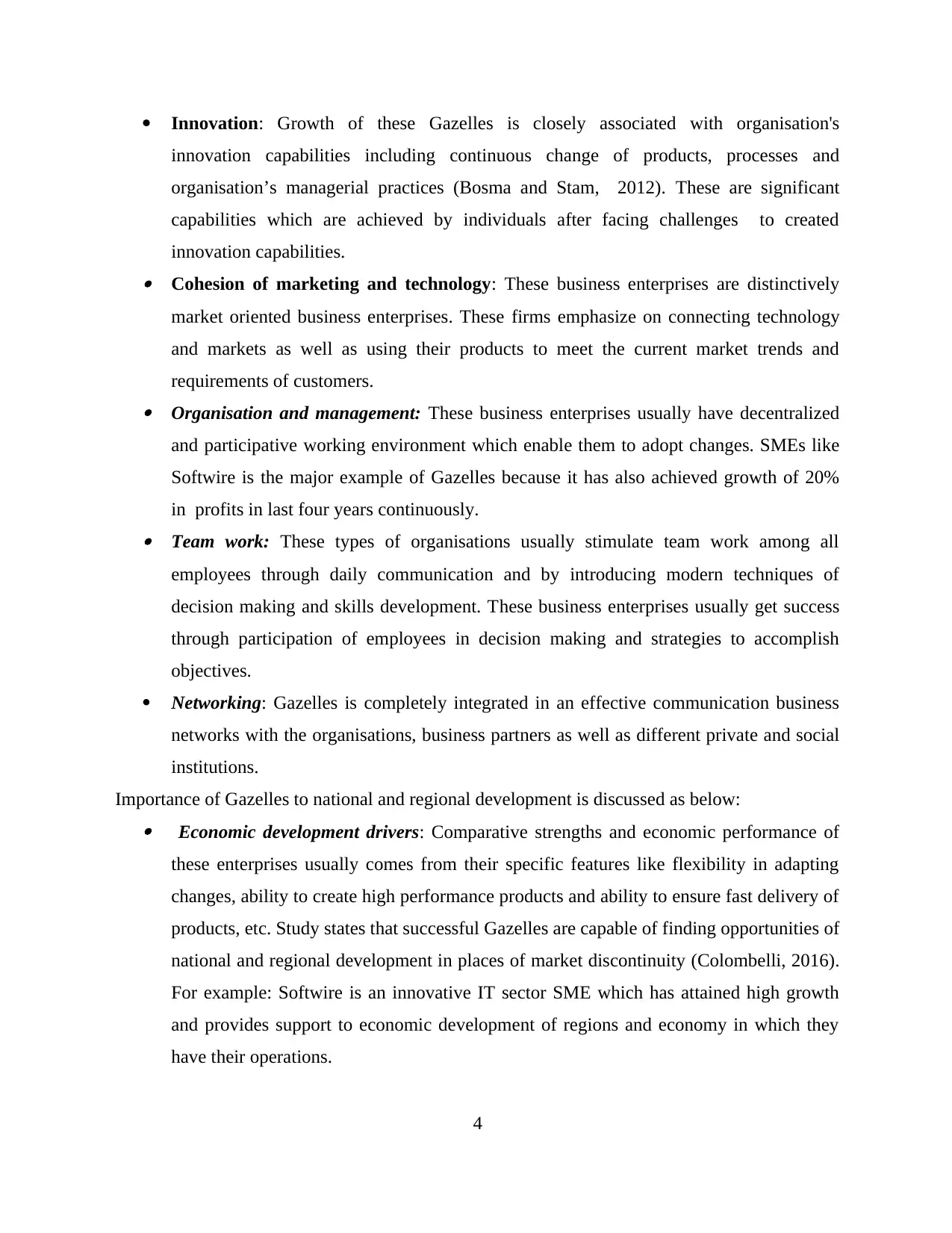
Innovation: Growth of these Gazelles is closely associated with organisation's
innovation capabilities including continuous change of products, processes and
organisation’s managerial practices (Bosma and Stam, 2012). These are significant
capabilities which are achieved by individuals after facing challenges to created
innovation capabilities. Cohesion of marketing and technology: These business enterprises are distinctively
market oriented business enterprises. These firms emphasize on connecting technology
and markets as well as using their products to meet the current market trends and
requirements of customers. Organisation and management: These business enterprises usually have decentralized
and participative working environment which enable them to adopt changes. SMEs like
Softwire is the major example of Gazelles because it has also achieved growth of 20%
in profits in last four years continuously. Team work: These types of organisations usually stimulate team work among all
employees through daily communication and by introducing modern techniques of
decision making and skills development. These business enterprises usually get success
through participation of employees in decision making and strategies to accomplish
objectives.
Networking: Gazelles is completely integrated in an effective communication business
networks with the organisations, business partners as well as different private and social
institutions.
Importance of Gazelles to national and regional development is discussed as below: Economic development drivers: Comparative strengths and economic performance of
these enterprises usually comes from their specific features like flexibility in adapting
changes, ability to create high performance products and ability to ensure fast delivery of
products, etc. Study states that successful Gazelles are capable of finding opportunities of
national and regional development in places of market discontinuity (Colombelli, 2016).
For example: Softwire is an innovative IT sector SME which has attained high growth
and provides support to economic development of regions and economy in which they
have their operations.
4
innovation capabilities including continuous change of products, processes and
organisation’s managerial practices (Bosma and Stam, 2012). These are significant
capabilities which are achieved by individuals after facing challenges to created
innovation capabilities. Cohesion of marketing and technology: These business enterprises are distinctively
market oriented business enterprises. These firms emphasize on connecting technology
and markets as well as using their products to meet the current market trends and
requirements of customers. Organisation and management: These business enterprises usually have decentralized
and participative working environment which enable them to adopt changes. SMEs like
Softwire is the major example of Gazelles because it has also achieved growth of 20%
in profits in last four years continuously. Team work: These types of organisations usually stimulate team work among all
employees through daily communication and by introducing modern techniques of
decision making and skills development. These business enterprises usually get success
through participation of employees in decision making and strategies to accomplish
objectives.
Networking: Gazelles is completely integrated in an effective communication business
networks with the organisations, business partners as well as different private and social
institutions.
Importance of Gazelles to national and regional development is discussed as below: Economic development drivers: Comparative strengths and economic performance of
these enterprises usually comes from their specific features like flexibility in adapting
changes, ability to create high performance products and ability to ensure fast delivery of
products, etc. Study states that successful Gazelles are capable of finding opportunities of
national and regional development in places of market discontinuity (Colombelli, 2016).
For example: Softwire is an innovative IT sector SME which has attained high growth
and provides support to economic development of regions and economy in which they
have their operations.
4
⊘ This is a preview!⊘
Do you want full access?
Subscribe today to unlock all pages.

Trusted by 1+ million students worldwide
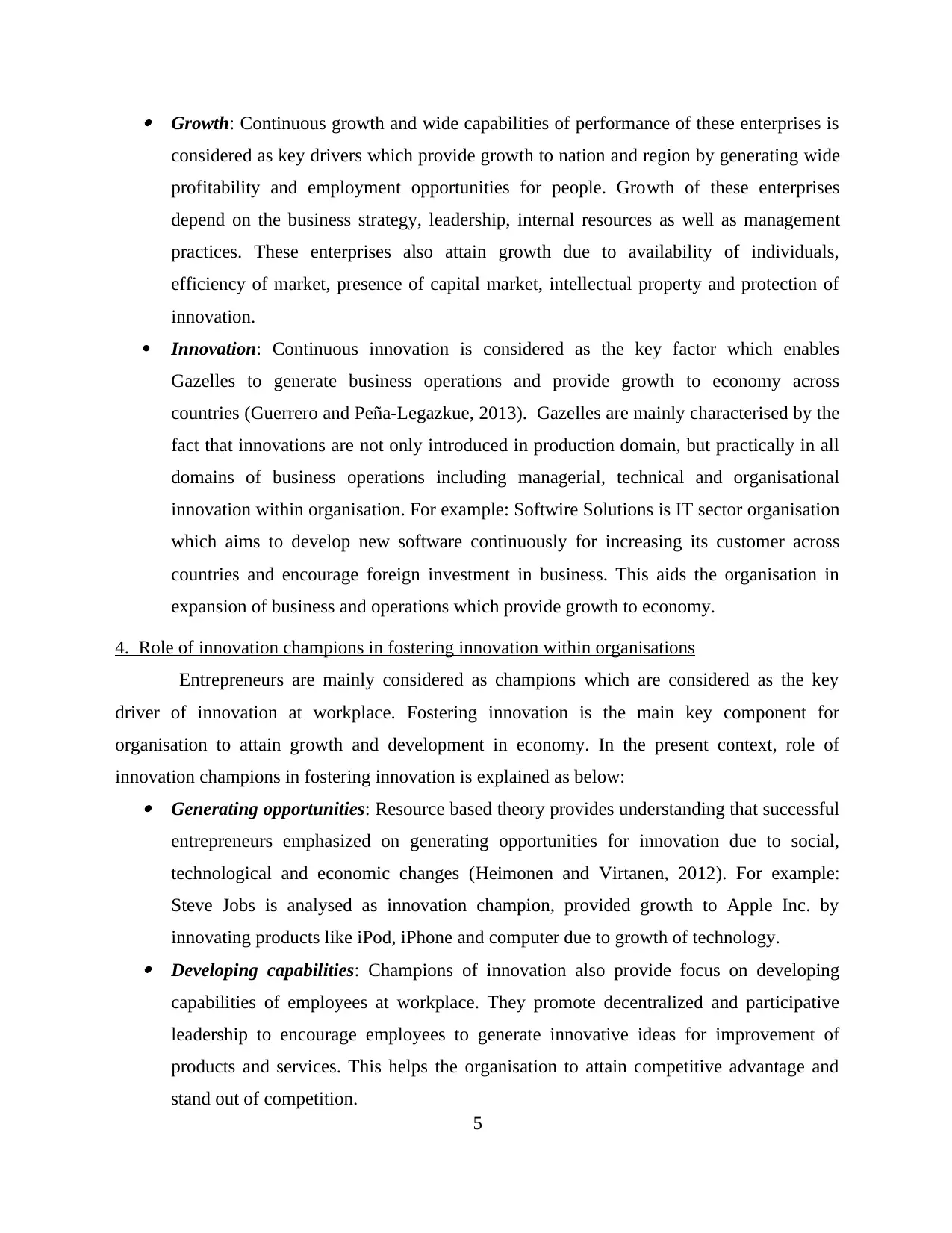
Growth: Continuous growth and wide capabilities of performance of these enterprises is
considered as key drivers which provide growth to nation and region by generating wide
profitability and employment opportunities for people. Growth of these enterprises
depend on the business strategy, leadership, internal resources as well as management
practices. These enterprises also attain growth due to availability of individuals,
efficiency of market, presence of capital market, intellectual property and protection of
innovation.
Innovation: Continuous innovation is considered as the key factor which enables
Gazelles to generate business operations and provide growth to economy across
countries (Guerrero and Peña-Legazkue, 2013). Gazelles are mainly characterised by the
fact that innovations are not only introduced in production domain, but practically in all
domains of business operations including managerial, technical and organisational
innovation within organisation. For example: Softwire Solutions is IT sector organisation
which aims to develop new software continuously for increasing its customer across
countries and encourage foreign investment in business. This aids the organisation in
expansion of business and operations which provide growth to economy.
4. Role of innovation champions in fostering innovation within organisations
Entrepreneurs are mainly considered as champions which are considered as the key
driver of innovation at workplace. Fostering innovation is the main key component for
organisation to attain growth and development in economy. In the present context, role of
innovation champions in fostering innovation is explained as below: Generating opportunities: Resource based theory provides understanding that successful
entrepreneurs emphasized on generating opportunities for innovation due to social,
technological and economic changes (Heimonen and Virtanen, 2012). For example:
Steve Jobs is analysed as innovation champion, provided growth to Apple Inc. by
innovating products like iPod, iPhone and computer due to growth of technology. Developing capabilities: Champions of innovation also provide focus on developing
capabilities of employees at workplace. They promote decentralized and participative
leadership to encourage employees to generate innovative ideas for improvement of
products and services. This helps the organisation to attain competitive advantage and
stand out of competition.
5
considered as key drivers which provide growth to nation and region by generating wide
profitability and employment opportunities for people. Growth of these enterprises
depend on the business strategy, leadership, internal resources as well as management
practices. These enterprises also attain growth due to availability of individuals,
efficiency of market, presence of capital market, intellectual property and protection of
innovation.
Innovation: Continuous innovation is considered as the key factor which enables
Gazelles to generate business operations and provide growth to economy across
countries (Guerrero and Peña-Legazkue, 2013). Gazelles are mainly characterised by the
fact that innovations are not only introduced in production domain, but practically in all
domains of business operations including managerial, technical and organisational
innovation within organisation. For example: Softwire Solutions is IT sector organisation
which aims to develop new software continuously for increasing its customer across
countries and encourage foreign investment in business. This aids the organisation in
expansion of business and operations which provide growth to economy.
4. Role of innovation champions in fostering innovation within organisations
Entrepreneurs are mainly considered as champions which are considered as the key
driver of innovation at workplace. Fostering innovation is the main key component for
organisation to attain growth and development in economy. In the present context, role of
innovation champions in fostering innovation is explained as below: Generating opportunities: Resource based theory provides understanding that successful
entrepreneurs emphasized on generating opportunities for innovation due to social,
technological and economic changes (Heimonen and Virtanen, 2012). For example:
Steve Jobs is analysed as innovation champion, provided growth to Apple Inc. by
innovating products like iPod, iPhone and computer due to growth of technology. Developing capabilities: Champions of innovation also provide focus on developing
capabilities of employees at workplace. They promote decentralized and participative
leadership to encourage employees to generate innovative ideas for improvement of
products and services. This helps the organisation to attain competitive advantage and
stand out of competition.
5
Paraphrase This Document
Need a fresh take? Get an instant paraphrase of this document with our AI Paraphraser
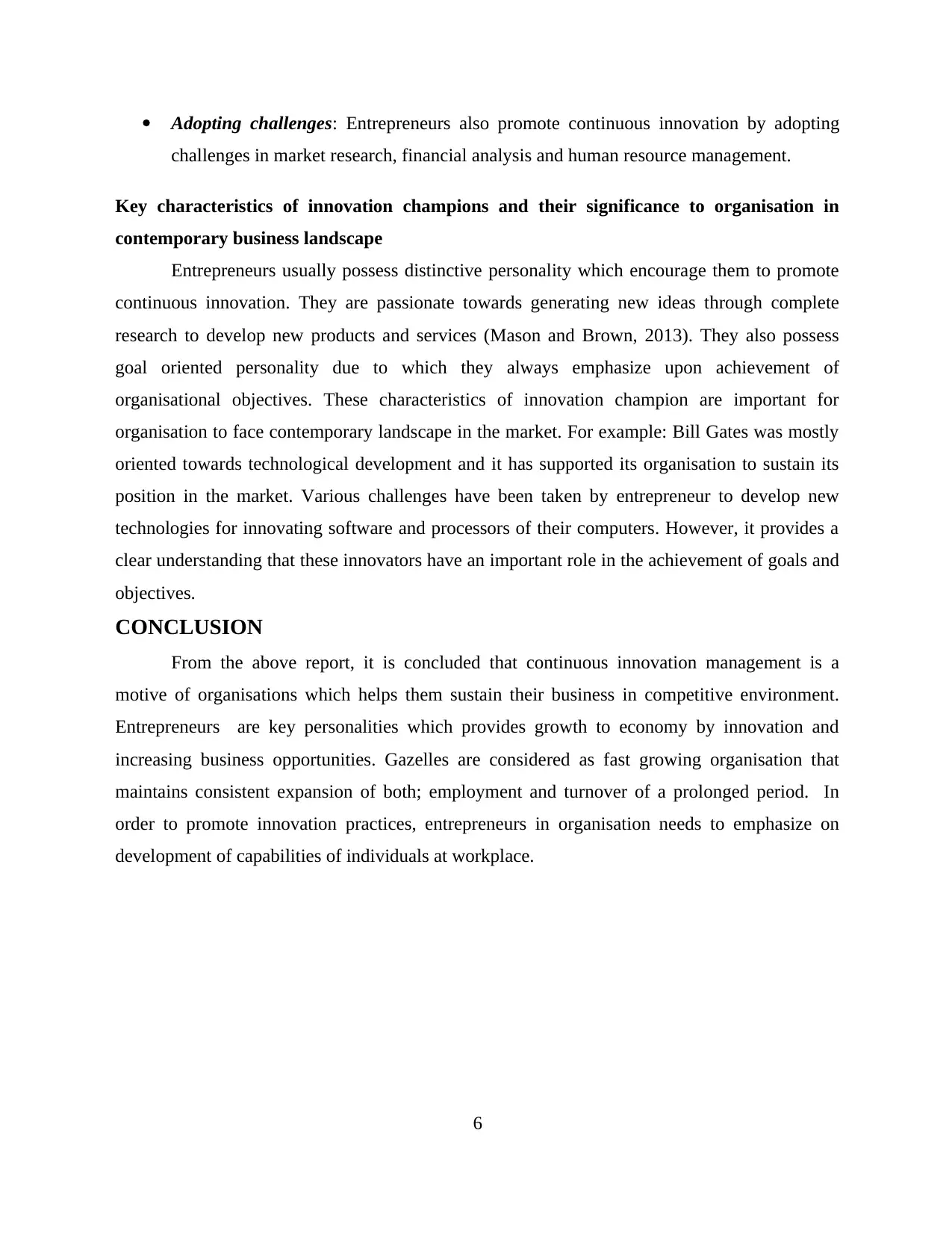
Adopting challenges: Entrepreneurs also promote continuous innovation by adopting
challenges in market research, financial analysis and human resource management.
Key characteristics of innovation champions and their significance to organisation in
contemporary business landscape
Entrepreneurs usually possess distinctive personality which encourage them to promote
continuous innovation. They are passionate towards generating new ideas through complete
research to develop new products and services (Mason and Brown, 2013). They also possess
goal oriented personality due to which they always emphasize upon achievement of
organisational objectives. These characteristics of innovation champion are important for
organisation to face contemporary landscape in the market. For example: Bill Gates was mostly
oriented towards technological development and it has supported its organisation to sustain its
position in the market. Various challenges have been taken by entrepreneur to develop new
technologies for innovating software and processors of their computers. However, it provides a
clear understanding that these innovators have an important role in the achievement of goals and
objectives.
CONCLUSION
From the above report, it is concluded that continuous innovation management is a
motive of organisations which helps them sustain their business in competitive environment.
Entrepreneurs are key personalities which provides growth to economy by innovation and
increasing business opportunities. Gazelles are considered as fast growing organisation that
maintains consistent expansion of both; employment and turnover of a prolonged period. In
order to promote innovation practices, entrepreneurs in organisation needs to emphasize on
development of capabilities of individuals at workplace.
6
challenges in market research, financial analysis and human resource management.
Key characteristics of innovation champions and their significance to organisation in
contemporary business landscape
Entrepreneurs usually possess distinctive personality which encourage them to promote
continuous innovation. They are passionate towards generating new ideas through complete
research to develop new products and services (Mason and Brown, 2013). They also possess
goal oriented personality due to which they always emphasize upon achievement of
organisational objectives. These characteristics of innovation champion are important for
organisation to face contemporary landscape in the market. For example: Bill Gates was mostly
oriented towards technological development and it has supported its organisation to sustain its
position in the market. Various challenges have been taken by entrepreneur to develop new
technologies for innovating software and processors of their computers. However, it provides a
clear understanding that these innovators have an important role in the achievement of goals and
objectives.
CONCLUSION
From the above report, it is concluded that continuous innovation management is a
motive of organisations which helps them sustain their business in competitive environment.
Entrepreneurs are key personalities which provides growth to economy by innovation and
increasing business opportunities. Gazelles are considered as fast growing organisation that
maintains consistent expansion of both; employment and turnover of a prolonged period. In
order to promote innovation practices, entrepreneurs in organisation needs to emphasize on
development of capabilities of individuals at workplace.
6
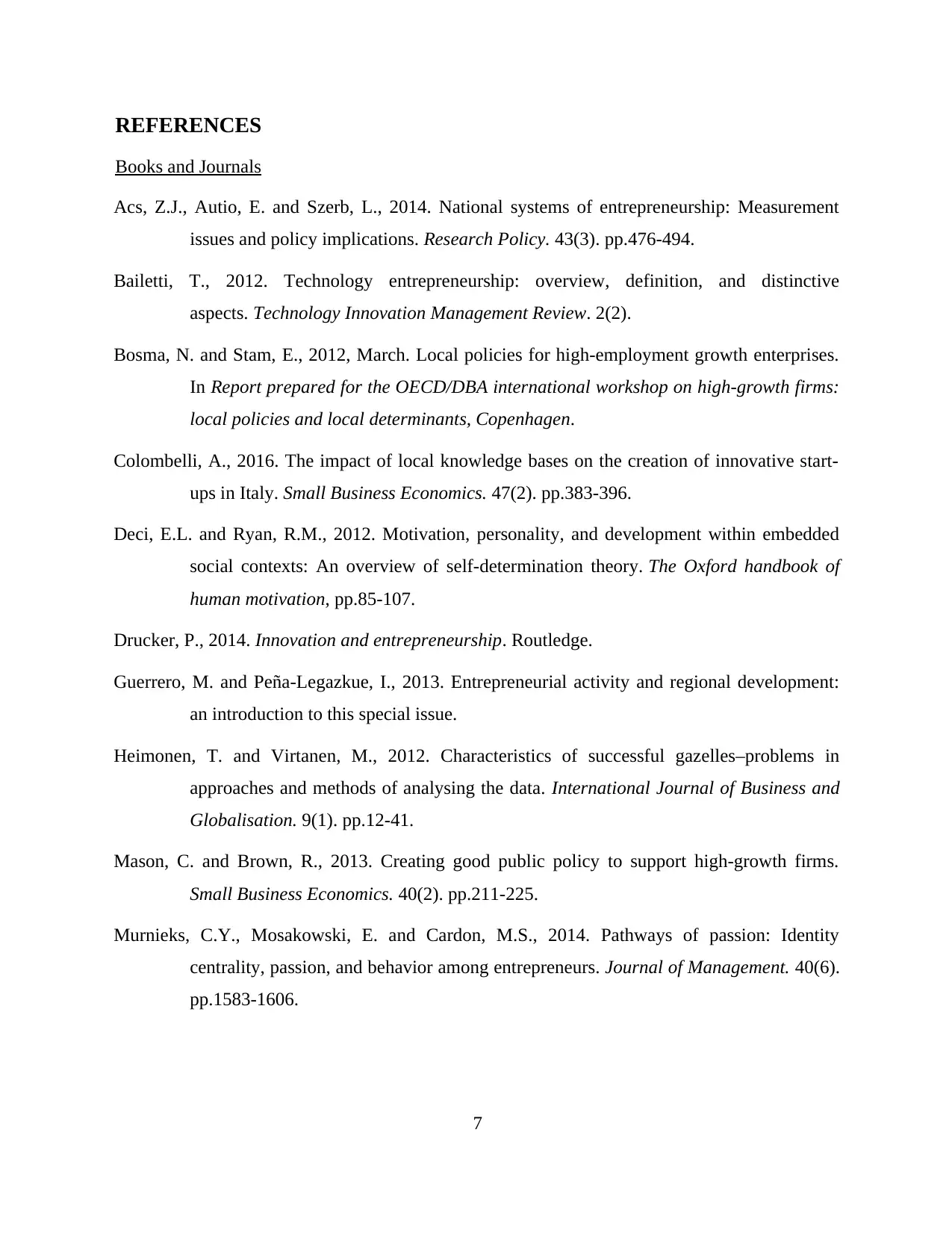
REFERENCES
Books and Journals
Acs, Z.J., Autio, E. and Szerb, L., 2014. National systems of entrepreneurship: Measurement
issues and policy implications. Research Policy. 43(3). pp.476-494.
Bailetti, T., 2012. Technology entrepreneurship: overview, definition, and distinctive
aspects. Technology Innovation Management Review. 2(2).
Bosma, N. and Stam, E., 2012, March. Local policies for high-employment growth enterprises.
In Report prepared for the OECD/DBA international workshop on high-growth firms:
local policies and local determinants, Copenhagen.
Colombelli, A., 2016. The impact of local knowledge bases on the creation of innovative start-
ups in Italy. Small Business Economics. 47(2). pp.383-396.
Deci, E.L. and Ryan, R.M., 2012. Motivation, personality, and development within embedded
social contexts: An overview of self-determination theory. The Oxford handbook of
human motivation, pp.85-107.
Drucker, P., 2014. Innovation and entrepreneurship. Routledge.
Guerrero, M. and Peña-Legazkue, I., 2013. Entrepreneurial activity and regional development:
an introduction to this special issue.
Heimonen, T. and Virtanen, M., 2012. Characteristics of successful gazelles–problems in
approaches and methods of analysing the data. International Journal of Business and
Globalisation. 9(1). pp.12-41.
Mason, C. and Brown, R., 2013. Creating good public policy to support high-growth firms.
Small Business Economics. 40(2). pp.211-225.
Murnieks, C.Y., Mosakowski, E. and Cardon, M.S., 2014. Pathways of passion: Identity
centrality, passion, and behavior among entrepreneurs. Journal of Management. 40(6).
pp.1583-1606.
7
Books and Journals
Acs, Z.J., Autio, E. and Szerb, L., 2014. National systems of entrepreneurship: Measurement
issues and policy implications. Research Policy. 43(3). pp.476-494.
Bailetti, T., 2012. Technology entrepreneurship: overview, definition, and distinctive
aspects. Technology Innovation Management Review. 2(2).
Bosma, N. and Stam, E., 2012, March. Local policies for high-employment growth enterprises.
In Report prepared for the OECD/DBA international workshop on high-growth firms:
local policies and local determinants, Copenhagen.
Colombelli, A., 2016. The impact of local knowledge bases on the creation of innovative start-
ups in Italy. Small Business Economics. 47(2). pp.383-396.
Deci, E.L. and Ryan, R.M., 2012. Motivation, personality, and development within embedded
social contexts: An overview of self-determination theory. The Oxford handbook of
human motivation, pp.85-107.
Drucker, P., 2014. Innovation and entrepreneurship. Routledge.
Guerrero, M. and Peña-Legazkue, I., 2013. Entrepreneurial activity and regional development:
an introduction to this special issue.
Heimonen, T. and Virtanen, M., 2012. Characteristics of successful gazelles–problems in
approaches and methods of analysing the data. International Journal of Business and
Globalisation. 9(1). pp.12-41.
Mason, C. and Brown, R., 2013. Creating good public policy to support high-growth firms.
Small Business Economics. 40(2). pp.211-225.
Murnieks, C.Y., Mosakowski, E. and Cardon, M.S., 2014. Pathways of passion: Identity
centrality, passion, and behavior among entrepreneurs. Journal of Management. 40(6).
pp.1583-1606.
7
⊘ This is a preview!⊘
Do you want full access?
Subscribe today to unlock all pages.

Trusted by 1+ million students worldwide
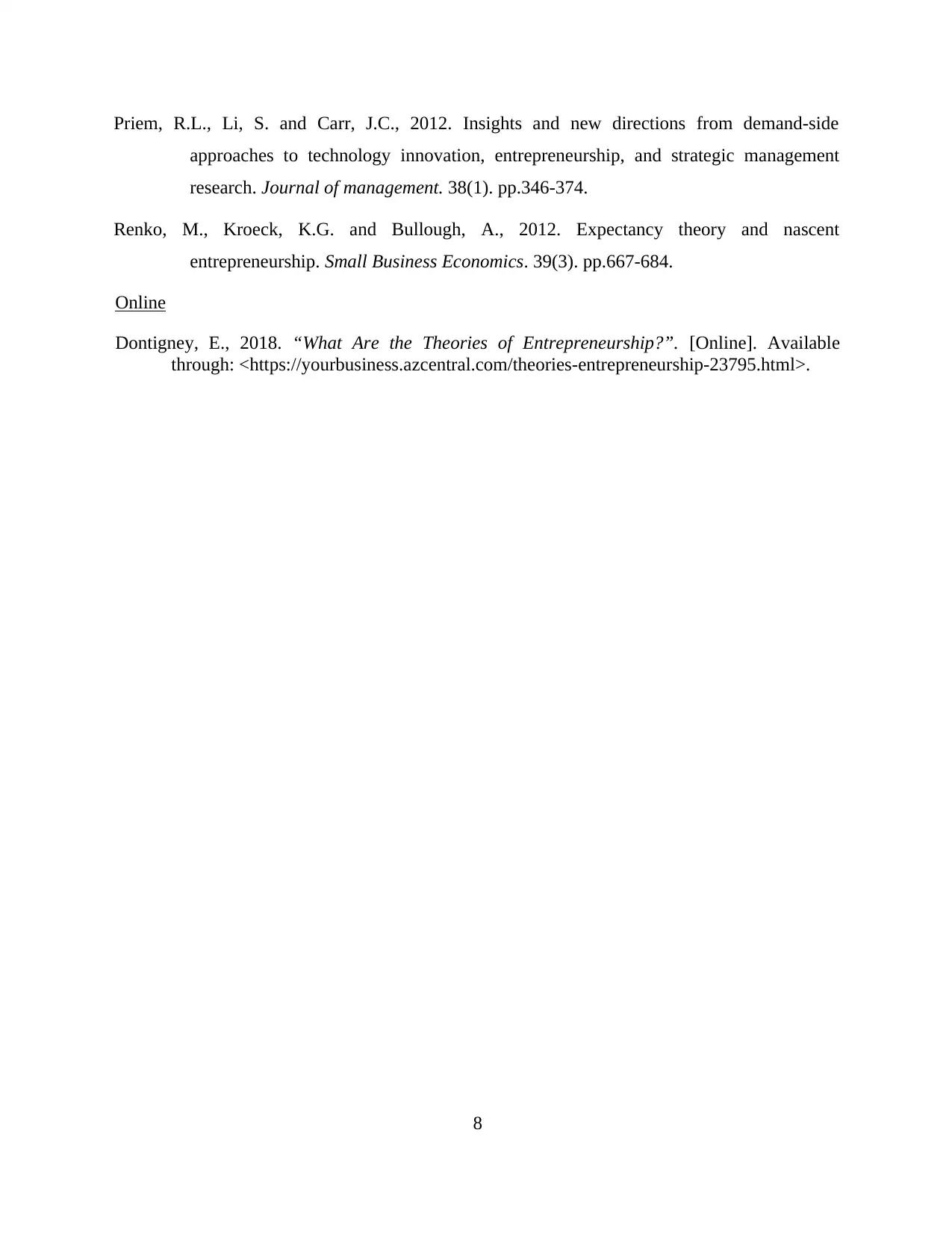
Priem, R.L., Li, S. and Carr, J.C., 2012. Insights and new directions from demand-side
approaches to technology innovation, entrepreneurship, and strategic management
research. Journal of management. 38(1). pp.346-374.
Renko, M., Kroeck, K.G. and Bullough, A., 2012. Expectancy theory and nascent
entrepreneurship. Small Business Economics. 39(3). pp.667-684.
Online
Dontigney, E., 2018. “What Are the Theories of Entrepreneurship?”. [Online]. Available
through: <https://yourbusiness.azcentral.com/theories-entrepreneurship-23795.html>.
8
approaches to technology innovation, entrepreneurship, and strategic management
research. Journal of management. 38(1). pp.346-374.
Renko, M., Kroeck, K.G. and Bullough, A., 2012. Expectancy theory and nascent
entrepreneurship. Small Business Economics. 39(3). pp.667-684.
Online
Dontigney, E., 2018. “What Are the Theories of Entrepreneurship?”. [Online]. Available
through: <https://yourbusiness.azcentral.com/theories-entrepreneurship-23795.html>.
8
1 out of 10
Related Documents
Your All-in-One AI-Powered Toolkit for Academic Success.
+13062052269
info@desklib.com
Available 24*7 on WhatsApp / Email
![[object Object]](/_next/static/media/star-bottom.7253800d.svg)
Unlock your academic potential
Copyright © 2020–2025 A2Z Services. All Rights Reserved. Developed and managed by ZUCOL.





